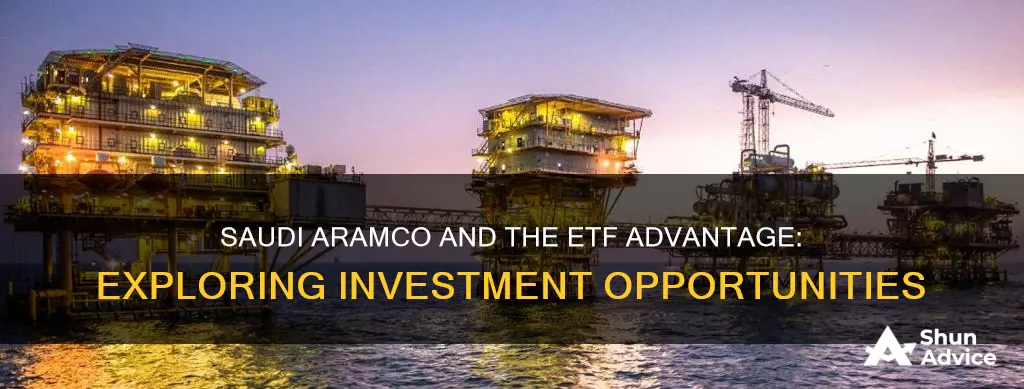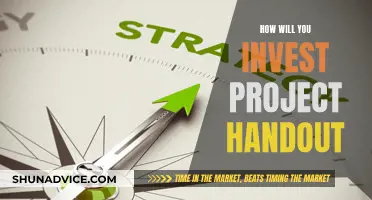
Saudi Aramco, the world's largest oil company, is selling around 1.5% of the company in what could become the world's largest initial public offering (IPO). The company's valuation has caused controversy, with investors balking at the price. The oil giant is expected to be valued at $1.6 trillion, far below the $2 trillion initially desired by the Saudi government.
Shares will not be sold to retail investors unless they are residents of Saudi Arabia. However, investors can buy exposure to the Saudi market through exchange-traded funds (ETFs) that invest in a single country and track the performance of the stock market. Once Aramco floats, a Saudi Arabian-only passive fund would have around 7% of its assets invested in the oil company.
There are two options for investors: the Invesco MSCI Saudi Arabia ETF and iShares MSCI Saudi Arabia Capped ETF. The former is a $60 million fund that tracks the MSCI Saudi Arabia 20/35 index and owns 30 stocks, equating to around 85% of the market. The latter is a $256 million fund that tracks the same market. Both ETFs trade in American dollars, so investors will be exposed to currency movements.
What You'll Learn

iShares MSCI Saudi Arabia ETF
The iShares MSCI Saudi Arabia ETF is an exchange-traded fund (ETF) that offers investors access to the Saudi Arabian stock market, which has historically been closed to foreign investors. This ETF seeks to track the investment results of a broad-based index composed of Saudi Arabian equities.
The fund provides targeted exposure to a country with growth potential and allows investors to express a single-country view. As of July 23, 2024, the Net Asset Value (NAV) was $41.94, with a 52-week range of 36.32 to 44.93. The 1-Day NAV Change on the same date was -0.30 (-0.70%). The expense ratio for this ETF is 0.74%.
The iShares MSCI Saudi Arabia ETF provides access to the Saudi market, which is relatively small compared to other global markets. The inclusion of Saudi Aramco, the world's largest oil company, in the Saudi market will significantly increase its overall value.
This ETF is denominated in US dollars, so investors should be aware of potential currency movements that could impact their investment. Additionally, investing in a single country, especially an emerging market like Saudi Arabia, carries a higher level of risk.
The iShares MSCI Saudi Arabia ETF provides a way for investors to gain exposure to the Saudi Arabian market, including Saudi Aramco, and benefit from its growth potential. However, as with any investment, there are risks to consider, including the potential for a bubble and the impact of currency fluctuations.
The Inflation Conundrum: Navigating the Investment Landscape
You may want to see also

Invesco MSCI Saudi Arabia ETF
The Invesco MSCI Saudi Arabia UCITS ETF (MSAU LN) is an exchange-traded fund incorporated in Ireland. The fund's objective is to achieve the performance of the MSCI Saudi Arabia 20/35 Index less fees, expenses, and transaction costs. The reference index is a free-float adjusted market capitalization index that covers about 85% of the market and is designed to measure the large and mid-cap segments of the Saudi Arabian market. The ETF provides exposure to 30 large and mid-cap stocks listed in Saudi Arabia.
The Invesco MSCI Saudi Arabia ETF is managed by Invesco, a global investment management firm. The fund was launched on June 12, 2018, and has grown to $315 million in assets under management as of March 4, 2019. The ETF is now the largest in the world providing exposure to the Persian Gulf state. The fund's TER (total expense ratio) is 0.50% per annum, and it charges a 0.20% swap fee.
The underlying MSCI index comprises 30 large and mid-cap stocks, accounting for approximately 85% of the free-float market capitalization in Saudi Arabia. The index contains various constraints to ensure it meets UCITS requirements for diversification. The weight of the largest constituent is capped at 35%, and the weight of any other single entity is limited to 20%.
The strong demand for the Invesco MSCI Saudi Arabia ETF reflects government efforts in recent years to boost the country's appeal as an investment destination. Reforms within the 'Saudi Vision 2030' programme aim to reduce the economy's dependency on government funding and oil exports, increase private sector consumption, boost employment in the private sector, and promote renewable energy sources.
Ethereum: Invest or Avoid?
You may want to see also

Saudi Aramco's valuation
The controversy surrounding Saudi Aramco's valuation stems from the fact that its valuation relies more on smoke and mirrors than the market's collective wisdom. The liquidity in Aramco shares is abysmal, with a daily average of just $51 million worth of stock changing hands over the past year. This is in stark contrast to companies like Exxon Mobil Corp., Apple, and Microsoft, which have much higher liquidity. Additionally, many buyers and sellers of Aramco shares are involved in what looks like merry-go-rounds, with Middle East investors, often controlled by regional governments or royals, trading with each other. The big institutional investors are notably absent.
The low liquidity in Aramco shares can be attributed to the fact that only 2% of the shares are available for trade, with the Saudi government still controlling 98% of the company's equity after its 2019 initial public offering (IPO). The government is now considering selling more shares, which may improve liquidity. However, investors need to actively trade the stock for this to happen. Since the IPO, many investors have treated Aramco as a buy-and-hold investment, similar to a perpetual bond.
Aramco's valuation is also questionable because it trades at a price-to-earnings (P/E) ratio of 13.5 times, nearly double that of Exxon. In mid-2021, the P/E ratio peaked at nearly 40 times. Such high P/E ratios are more typical of shoot-for-the-moon tech stocks rather than an old-fashioned oil company. Consequently, Aramco offers a dividend yield of just 3.8%, compared to nearly 4.5% for BP Plc.
Furthermore, investors can achieve higher yields by investing in Saudi government debt. For example, a yield of 4.6% can be obtained from two-year Saudi government debt denominated in dollars, and 5.5% on 30-year sovereign bonds. Shares rank below debt in any capital structure, so it is unclear why a foreign investor would accept a lower yield on riskier Saudi exposure.
Despite the concerns about Aramco's valuation, the company maintains that low liquidity is not deterring investors. Aramco believes it offers investors "unrivalled profitability, cash flow and returns". Additionally, the Saudi government is trying to attract more investors by juicing dividends and promising to top up its regular dividend with a "performance" dividend.
Retirement Planning: Why Investing Early is Key
You may want to see also

Saudi Aramco's share price
The state-owned oil giant is selling around 1.5% of the company in what could become the world's largest initial public offering (IPO). The company's valuation has been a topic of controversy, with investors questioning the price. Saudi Aramco is expected to be valued at $1.6 trillion, far below the Saudi government's initial goal of $2 trillion.
There are a few ways for investors to gain exposure to Saudi Aramco and the broader Saudi market. One option is through exchange-traded funds (ETFs) that invest in a single country and track the performance of the stock market. Once Aramco floats, a Saudi Arabian-only passive fund is expected to have around 7% of its assets invested in the oil company. Two examples of such ETFs are the Invesco MSCI Saudi Arabia ETF and the iShares MSCI Saudi Arabia Capped ETF.
Another option is to invest in an emerging market fund, although this is unlikely to provide significant exposure to Aramco, as the country would only ever be a small holding, given its 2.6% share of the MSCI Emerging Markets index.
It is important to note that shares will not be sold to "retail investors" unless they are residents of the Kingdom of Saudi Arabia. Therefore, investors interested in purchasing Saudi Aramco shares should carefully consider their options and conduct comprehensive analysis before making any investment decisions.
The Retirement Myth: Why Paying Off Debt Should Be Your Priority
You may want to see also

Saudi Aramco's dividend disbursements
Dividend Payments:
Saudi Aramco has a history of providing substantial dividend payments to its shareholders. In 2022, the company reported a record-breaking profit of $161 billion, resulting in a dividend payout of $161 billion to its shareholders. This amount represented the highest dividend payment ever made by the company.
Impact of Profit Decline:
Despite a 25% decline in profits in 2023, Saudi Aramco announced plans to boost its dividend payments further. The company's profits fell to $121 billion due to reduced production and a sharp decline in oil prices. However, the company still committed to increasing its dividend disbursements.
Dividend Increase:
In 2024, Saudi Aramco announced that its dividends would increase to $98 billion, representing a significant rise of almost a third compared to the previous year. This increase came as a result of the company's strong cash flows and high levels of profitability, even amidst economic challenges.
Ordinary Dividend Declaration:
Saudi Aramco declares its ordinary dividend for each quarter in Saudi Riyal (SAR) to both institutional and individual public shareholders. The company provides a dividend payment table on its website, outlining the upcoming ordinary ex-date and payment dates.
Exchange-Traded Funds (ETFs):
Investors seeking exposure to Saudi Aramco's dividend disbursements can consider investing in Exchange-Traded Funds (ETFs) that track the Saudi Arabian market. Examples of such ETFs include the Invesco MSCI Saudi Arabia ETF and the iShares MSCI Saudi Arabia Capped ETF. These ETFs provide diversified exposure to the Saudi market, including a significant allocation to Saudi Aramco once it floats in the market.
In summary, Saudi Aramco's dividend disbursements have been substantial, and the company has continued to prioritise shareholder returns despite fluctuations in the energy market. Investors seeking exposure to these disbursements can consider investing in ETFs that track the Saudi Arabian market, providing an opportunity to benefit from the company's performance and its impact on the region's economy.
Investing Globally: Picking the Right Countries
You may want to see also
Frequently asked questions
There are two options for investors: the Invesco MSCI Saudi Arabia ETF and iShares MSCI Saudi Arabia Capped ETF. Both exchange-traded funds (ETFs) trade in American dollars, so investors will be exposed to currency movements.
The former is a $60 million fund that tracks the MSCI Saudi Arabia 20/35 index. It owns 30 stocks equating to around 85% of the market. The fund, which was launched in June last year, has made investors 2.6% in its brief history, while the Saudi market has risen 3.4%. It has a fee of 0.7%.
The $256 million iShares fund tracks the same market. Launched in April this year, it has lost investors 12.7% while the market is down 12.4%. It has an ongoing charge of 0.6%.
Yes, there are several risks and drawbacks to consider before investing in Saudi Aramco. Firstly, shares will only be available to buy on the Tadawul in Riyadh, at least initially. Secondly, the public float will be relatively small, at around 2% of shares. The monarchy has used Aramco as a piggy bank in the past, and global investors should not expect to have any shareholder rights. The liquidity of shares in the first few months is likely to be lower than expected, and there are concerns about a potential bubble, with reports of Saudis going to extreme lengths to invest in the stock.







